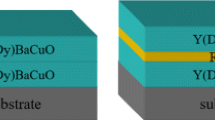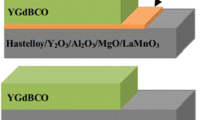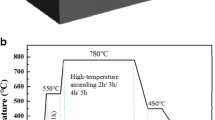Abstract
DyBa2Cu3O7−δ /YBa2Cu3O7−δ multilayer thick films were prepared on oxide-buffered Hastelloy substrates by low fluorine metal organic deposition (MOD) process with a thickness ranging from 0.7 μm to 2.8 μm. In the thickness of 1.4 μm sample, transition temperature (T c) and critical current density (J c) are 91.2 K and 2.5 MA/cm 2 (at 77 K, self field) respectively. With increasing thickness, T c drops as well as J c. Unfortunately, the critical current (I c) does not reach an ideal value when the thickness is 2.8 μm just only 365A/cm width as thickness is 2.1 μm. Rough surface structure, compressive, and tensile stress in the interlamination and Ba-Cu-O mixed phase were found in layer thickness of 2.1 μm and 2.8 μm are assumed to be the main reason for the limitation of the current transport.
Similar content being viewed by others
Avoid common mistakes on your manuscript.
1 Introduction
Second-generation high-temperature superconducting wires based on the REBa2Cu3O7−δ (REBCO, Re = Y, Gd, Sm, Dy, etc.)-coated conductors (CCs) have emerged as hot topics due to power transport and device applications in high magnetic fields [1–3]. Among various approaches making superconducting layer, the metal organic deposition (MOD) is an attractive technique for low-cost, high-rate deposition of REBCO CCs, applicable in atomosphere ambient pressure, in comparison with other methods including PLD [4–11].
For the commercialization of CCs, there exist two critical issues, i.e., the achievement of high production rate and the improvement of J c properties. Therefore, major efforts are made to optimize deposition processes, conductor architecture, and material properties [12]. It is reported that critical current density (J c) values and flux pinning force density can be improved by adding elements to YBCO samples [4, 5]. In particular, it is worthwhile to notice that RE doping can result in a significant enhancement of J c for REBCO superconductors [13, 14]. In MOD process, RE doping can be easily realized, as the composition of the films can be easily changed through chemical modification in the MOD precursor solution.
In our previous work, it is observed that understanding the dependence is important, as the thickness of the superconducting layer is one way to enhance the transport current of coated conductors. We focus on the limitation of I c due to structural changes with increasing YBCO thickness for the case of the IBAD-MgO metallic substrate buffered by LaMnO3 (LMO).
By studying the crystalline orientation, morphology and surface quality, and critical current density, we attempt to understand the main reason for the limitation of the current transport on DyBCO/YBCO in low fluorine MOD process.
2 Experimental
Stoichiometric quantities of Y, Dy, and Ba acetates were dissolved in de-ionized water with an excess stoichiometric quantity of trifluoroacetic acid, Cu (Dy: Ba: Cu = 1: 2: 3.3; Y: Ba: Cu = 1: 2: 3.3) acetate was dissolved in de-ionized water with an excess of propionic acid to get the coating solution. The next step in solution preparation was refining the solution by drying, and redissolving in methanol several times. This process removed the excess acetic acid, water, and other impurities from the solution. Finally, the Y/Dy, Ba, and Cu solutions were mixed, evaporated, and diluted in propionic acid to control the viscosity substrates by dip-coating.
Next, Y/DyBCO precursor films are deposited on Hastelloy/Al2O3/Y2O3/IBAD-MgO/LaMnO3 substrate by a coating process and various thicknesses are obtained by changing the coating times. For a certain sample, each coating process is kept the same. The concentration of the used precursor solution is 2.5 mol/L. Subsequently, continuous heated treatment is applied including three steps: (1) low-temperature paralysis; 2) high-temperature crystallization, and (3) annealing oxygenization. The consuming time for obtaining such as four times coated YBCO thick film is about 5 h, which is reduced greatly compared with other reports [15].
X-ray diffraction θ–2 θ scans and φ-scans (Philips X’ Pert PRO, Cu Ka, λ = 1.54185 Å) are measured to evaluate the structure and the texture of the grown films. In order to get the quantitative estimate of the a-axis/ c-axis volume fraction, we adopted the following procedure. After a χ rotation of about 57 ∘, the (102) reflection intensity is optimized with respect to ω and 2 θ. Then, a χ-scan in the range 15 ∘ to 70 ∘ is performed. The (102) planes of (100)- and (001)-oriented grains show a different tilt angle χ. Therefore, the reflections due to a-axis grains and to c-axis grains are completely separated. Raman spectroscopy (INVIA) is used to investigate residual stress in the film. The surface and cross-section image is observed with an scanning electron microscope (Ap0110300). The critical current density (J c) of the YBCO-coated conductor is examined by inductive measurement using a Cryoscan by Theva, and the voltage criteria for J c measurement is 50 μv.
3 Results and Discussion
3.1 Surface Morphology and Texture Analysis
A top view SEM image of 1.4 μm and 2.8 μm-thick films are shown in Fig. 1. The typical structure of DyBCO/YBCO with merging islands and pinholes are found for 0.7 μm and 1.4 μm-thick films (Fig. 1a). The island becomes larger and more separated form each other with increasing film thickness. The typical grain size increase from 0.3 μm (d = 1.4 μm) to 0.8 μm (d = 2.8 μm). This is also reflected in the width of YBCO(OOl) peak in the θ–2 θ scans, where the peaks get narrower with increasing thickness (data is not shown). Elongated a-axis (marked with red narrows in Fig. 1b) and Ba-Cu-O impure phase (marked with blue arrows in Fig. 1b) are visible above 0.7 μm.
The separation and enlargement of the grains is also evident in the RMS values and the average height of the surface top-view graph obtained by AFM in 5 × 5 μm 2 and 10×10 μm 2 scans (Table 1 and Fig. 2). The RMS value rises from about 20 nm (d = 0.7 μm) to 40 nm (d = 2.1 μm). A further distinct increase with thickness to a value of 70 nm (d = 2.8 μm) is only visible at the 10- μm scale, due to the emerging disoriented grains. The same applies for the average height, providing more realistic values of the extension of vertical structures on the surface. On the local 5- μm scale, the RMS and average height values are comparable to the values measured at thinner films. We did not observe indications of cracks or delamination, even in 2.8– μm-thick films.
The XRD patterns of DyBCO/YBCO with thickness of 1.4 μm, 2.1 μm and 2.8 μm are shown in Fig. 3. The scans show a pure c-axis oriented growth of YBCO up to a thickness of 2.8 μm. Additional peaks of (110)- and (103)-oriented YBCO were observed in thicker films (in Fig. 3). The intensity of the a-axis peaks (YBCO(200)) increase further with thickness.
We found a little peak of BaF2 in the sample with thickness of 2.1 μm and 2.8 μm, which becomes more dominant in thicker films. The appearance of BaF2 peaks in the thick films is typical for our MOD films. They show a common phenomenon during the chemical reaction of chemical vapor deposition (CVD); in the process of this reaction, F-Ba process is complex and the chemical reaction time is sharp; furthermore, which is intense, it is hard to avoid a small amount of BaF2 and other impure phase (such as Ba-Cu-O) appearances.
Closed pores (marked by blue arrows in Fig. 4). Additionally, they might be a starting point for the growth of disoriented YBCO. Therefore, a reduction of the size of the particles could help to reduce the amount of pores, lower the surface and prevent disorientations.
Energy dispersive X-ray spectrometry (EDS) elemental maps of the DyBCO/YBCO multilayer film are shown in Fig. 5; elements such as Dy, Y, Ba, Cu, O, and Pt were analyzed. As seen in Fig. 5, in the middle area of DyBCO/YBCO multilayer film, almost the contact area between the second and the third layer, there are some pores, which are marked with the rectangular dotted line in Fig. 5, the reason may be that during the low-temperature decomposition, Cu element diffuses faster than other elements, only left uneven distribution, and it is also possible that the decomposition of low temperature HF gas releases excessive residual cavity. Dy, Y, and Ba elements were dispersed homogeneously in the entire film. However, Ba dispersed thickness was seen to be thinner than that with O and Cu elements which were aggregated near the film surface as oxides. These segregated precipitates can be considered as non-reacted phases which could not transform to Y123 phase, which are marked with the circular dotted line in Fig. 5.
Our measurements of the IBAD template show an in-plane FWHM value of 8.3 ∘ for LMO (111) and the typical FWHM values of 4.0 ∘ were found for the YBCO (103) peaks. The dependence on the YBCO thickness is shown in Fig. 6a for a number of samples. We found that the peak width is slightly reduced with increasing thickness and reaches a value of around 2.06 ∘ at d = 2.1 μm. However, the peak width is rapidly increased to 2.96 ∘ when the thickness reaches 2.8 μm. The improved texture and the increasing grain size indicate some kind of growth selection mechanism, where unfavorable textured grains are overgrown. On the other hand, also, the longer processing time for thicker films may lead to an improvement of the texture as there is more time for the atoms to find an energetic favorable position.
In comparison, the out-of-plane alignment remained constant within the uncertainty of the measurement, with FWHM values of about 1 ∘ for YBCO (005), which is just following the same change rule of decreasing as the thickness increases from 0.7 μm to 2.1 μm, and then becomes bigger as the thickness reach to 2.8 μm.
3.2 Superconducting Properties
Figure 7a shows the inductive critical current density at 77 K under self field. In our sample, Jc reaches 3.0 MA/cm 2 as a maximum local value and around as the highest average value in the thinnest sample (d = 0.7μm). Clearly, the critical current density (J c) values decreasing from 3.0 to 1.2 MA/cm 2 as the thickness increasing from 0.7 μm to 2.8 μm, which dropped quickly as soon as possible (Fig. 7a). Nevertheless Ic is increasing strongly up to d = 2.1μm. Above this thickness, Ic also cannot increase as the thickness of the thick film, which may be due to the “thick effect” that was observed in [16, 17]. This limitation is in line with the appearance of disoriented YBCO grains and large impure phase, as described above. Additionally, the increasing volume fraction of pores and Cu-rich phase are limiting the superconducting cross section and Ic.
4 Conclusions
In summary, we deposited DyBCO/YBCO multilayer thick filmswithathicknessrangingfrom0.7 μmto2.8 μm on IBAD-MgO substrate buffered by LMO substrate. We observed the RMS of the thick surface becoming coarsened with an increasing of the thickness, as well as the appearance of disorienting and impure phases for films thicker than 2.1 μm. In-plane and out-plane texture decreases as the thickness increasing, when the thickness reach a certain thickness (d = 2.1μm) which will become bigger than before. The YBCO film seems to be compressed in-plane up to d = 2.1μm leading to an increased c-axis lattice parameter and higher Tc in thinner films. At 77 K, a Jc of around 3.0 MA/cm 2 was measured in the thinnest sample (d = 0.7μm). As the film thickness increases to 2.8 μm, Jc drops to a value of 1.2 MA/cm 2. We conclude that LMO buffered IBAD-MgO can act as a sufficient template for YBCO-coated conductors.
References
Iguchi, T., Araki, T., Yamada, Y., Hirabayashi, I., Ikuta, H.: Supercond. Sci. Technol. 15, 1415-1420 (2002)
Rupich, M. W., Verebelyi, D. R., Zhang, W., Kodenkandath, T., Li, X.: Mater. Res. Soc. Bull. 29, 572–578 (2004)
Miyata, S., Matsuse, K., Ibi, A., Izumi, T., Shiohara, Y., Goto, T.: 26, 045020 (2013)
Wen, H.H., Yang, W.L., Zhao, Z.X.: Physica C 341, 1735–1738 (2000)
Engel, S., Thersleff, T., Hühne, R., Schultz, L., Holzapfel, B.: Appl. Phys. Lett. 90, 102505 (2007)
MacManus-Driscoll, J.L., Foltyn, S.R., Maiorov, B., Jia, Q.X., Wang, H., Serquis, A., Civale, L., Lin, Y., Hawley, M.E., Maley, M.P., Peterson, D.E.: Appl. Phys. Lett. 86, 032505 (2005)
Cai, C., Holzapfel, B., Hänisch, J., Fernandez, L., Schulz, L.: Appl. Phys. Lett. 84, 377 (2004)
Obradors, X., Martínez-Julián, F., Zalamova, K., Vlad, V.R., Pomar, A, Palau, A., Llordés, A., Chen, H., Coll, M., Ricart, S., Mestres, N., Granados, X., Puig, T., Rikel, M.: Physica C 482, 58–67 (2012)
Matsui, H., Sohma, M., Yamaguchi, I., Manabe, T., Kumagai, T.: Physics Procedia 36, 1643–1648 (2012)
Jian, H., Shao, D., Yang, Z., Zhu, X., Sun, Y.: Physica C 488, 39–45 (2013)
Miura, M., Kato, T., Yoshizumi, M., Yamada, Y., Izumi, T., Hirayama, T, Shiohara, Y.: Appl. Phys. Express 2, 023002 (2009)
Obradors, X., Puig, T.: Supercond. Sci. Technol. 27, 4 (2014)
Fang, J., Wu, N., Tong, W., Ling, L., Zhang, L., Xi, C., Pi, L., Sun, Y., Zhan, Y.: J. Appl. Phys. 113, 083904 (2013)
Nakamura, T., Nakahata, K., Yoshizumi, M., Izumi, T., Shiohara, Y., Kimura, K., Hasegawa, T., Kato, T., Hirayama, T.: Physics Procedia 45, 153–158 (2013)
Araki, T., Hirabayashi, I.: Supercond. Sci. Technol. 16, 71–94 (2003)
Develos-Bagarinao, K., Yamasaki, H., Nie, J.C., Nakagawa, Y.: Supercond. Sci. Technol. 18, 667–674 (2005)
Foltyn, S.R. et al.: Appl. Phys. Lett. 75, 3692 (1999)
Acknowledgments
This work was supported in part by Shanghai Key Laboratory of High Temperature Superconductors (14DZ2260700), the Science and Technology Commission of Shanghai Municipality (13111102300 and 14521102800), the National Natural Science Foundation of China (51572165, 11174193 and 51202141).
Author information
Authors and Affiliations
Corresponding author
Rights and permissions
About this article
Cite this article
Cui, Cw., Liu, Zy., Lin, Jx. et al. Thick DyBCO/YBCO Multilayer Films on LaMnO3 Substrate Derived by Metal Organic Deposition Method. J Supercond Nov Magn 29, 1611–1616 (2016). https://doi.org/10.1007/s10948-016-3419-0
Received:
Accepted:
Published:
Issue Date:
DOI: https://doi.org/10.1007/s10948-016-3419-0











